
7 minute read
DR KAS HAMMAN - CONTINENTAL DRIFT
CONTINENTAL DRIFT AND ITS EFFECT ON THE EVOLUTION OF SPECIES
By: Dr Kas Hamman
Advertisement
Previous articles focused on the interesting phenomena of Island or isolation evolution and how it gave rise to unique forms of lifeadaptations on Islands such as Madagascar, New Zealand, Australia, the Galápagos Islands and many others. Scientists concur that the earth is about 4.6 billion years old. There is also no doubt that for long periods of time, the earth has undergone some drastic changes. Over millions of years various forms of life on earth has had to adapt to ever changing environmental conditions in order to survive. These physical changes to our planet are without doubt strong drivers of evolution as the species that live on our planet in that particular period of time have to adapt to change as the planet itself changes. These changes can come from internal or external sources and are part of ongoing natural processes.
Continental Drift
The ground that we stand and live on every day may feel stationary and solid, but in reality, it is not the case. The continents on earth are divided up into large “plates” that move and float on the liquid-like rock that makes up the mantle of the earth. These plates are like rafts that move as the convection currents in the mantle move below them and are called tectonic plates. The actual movement of these plates can now be measured quite accurately by sensitive instruments on geostationary satellites. Some plates move faster than others, but all are moving, although at a slow rate of only a few centimetres, on average, per year. The continual movement of these tectonic plates leads to what scientists refer to as “continental drift”. Continents move apart and come back together depending on which way the plates on which they are attached are moving. The continents have all been one big landmass at least twice in the history of the earth. These supercontinents were called Rodinia and Pangaea. Rodinia was the first super-continent that formed about 1.3 billion years ago and started breaking up about 900 million years ago.
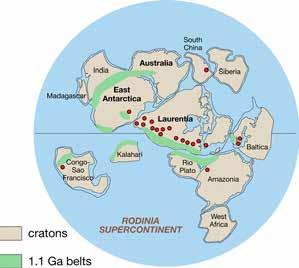
Theoretical reconstruction of the Rodinia super continent 900 million years ago
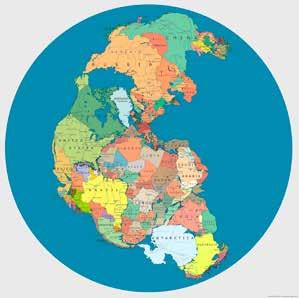
The original Pangea Continent about 300 million years ago
The southern part of Pangaea is known as Gondwana, which also started braking up over the following 100 million years.
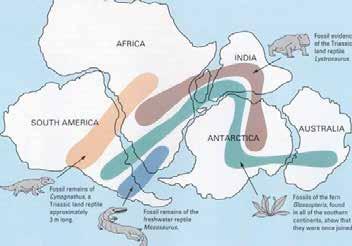
Fossils of identical plant & animal species found on now detached sections of the Gondwana super continent
Eventually, the continents of the earth will come back together again at some point in the future to create a new supercontinent which is currently dubbed “Pangaea Ultima”.
How does continental drift affect evolution?
As continents broke apart from Pangaea and later Gondwana, species got separated by seas and oceans and speciation occurred as result of isolation and changing environmental conditions. Individuals of species that were once able to interbreed were reproductively isolated from one another and over time acquired adaptations that made them genetically incompatible. New species evolved as a result of the isolation of continents and islands as dealt with in previous articles. As the continents drifted, they gradually moved into new climate zones. For example, a continent that was once at the equator may later be near the poles. Species that were unable to adapt to these changes in the weather and temperature, simply did not survive and went extinct. Species able to adapt and survive under such changed environmental conditions, often thrived in new areas.
Global climate change
As individual continents and their species drifted to new climate zones, these species had to deal with different climates. The earth has periodically shifted between very cold ice-ages across the planet, to extremely hot conditions. These changes are due to various factors such as slight changes to our orbit around the sun, changes in ocean currents, and the build-up of greenhouse gases such as carbon dioxide, among other internal sources. Irrespective of the cause, such sudden, or gradual climate
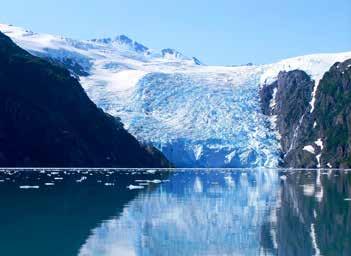
changes force species to adapt and evolve or go extinct. Periods of an extreme cold usually result in glaciation, which reduces the sea levels. Anything that lives in an aquatic environment would be affected by this type of climate change. On the other hand, rapidly increasing temperatures melt ice caps and raise the sea levels. In fact, periods of extreme cold or extreme heat have often caused rapid mass extinctions of species that could not adapt in time throughout the Geologic Time Scale. It is interesting to note that approximately 90% of species that once lived on earth have gone extinct through natural causes over the last 500 million years.
Volcanic eruptions
Although volcanic eruptions can cause widespread destruction, such events did in fact occur and did often drive evolution. One such eruption happened within recorded history in the 1880s. The Indonesian volcano Krakatau erupted and the huge amount of ash and debris managed to reduce the global temperature significantly by blocking out the sun. If several volcanoes were to erupt in this manner during the same time period, it could cause significant and rapid changes in climate which in turn are often drivers of evolution.
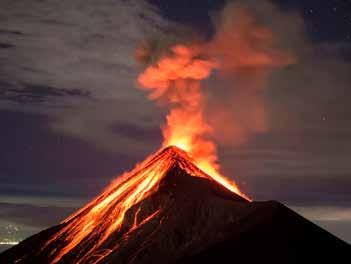
Volcano eruptions
These volcanoes most probably did contribute significantly to early life speciation and adaptations of species that contributed to the diversity of life that continued as time passed.
Space debris
Meteors, asteroids, and other space debris hitting the earth are actually a pretty common occurrence. However, thanks to the earth’s thick atmosphere, extremely large pieces of these extra-terrestrial chunks of rock usually do not make it to the earth’s surface to cause damage. However, earth did not always have an atmosphere for the rock to burn up in before making it to the earth.

Space debris
Much like volcanoes, meteorite impacts can severely alter the climate and cause significant changes in earth’s species — including mass extinctions. In fact, a very large meteor impact near the Yucatan Peninsula in Mexico is thought to be the cause of the mass extinction that wiped out the land dinosaurs at the end of the Mesozoicera 65 million years ago. These impacts can also release ash and dust into the atmosphere and can cause large changes in the amount of sunlight that reaches the earth. Not only does such events affect global temperatures, but a prolonged period of no sunlight can affect the energy getting to the plants that can undergo photosynthesis. Without energy production by plants, animals would soon run out of food to eat and energy to survive.
Atmospheric changes
To date, earth is the only planet in our Solar System with known life. There are many reasons for this such as we are the only planet with liquid water and the only one with large amounts of oxygen in the atmosphere. Our atmosphere has undergone many changes since the earth was formed. The most significant change came during what is known as the oxygen revolution. As life began to form on earth, there was little to no oxygen in the atmosphere. As photo synthesizing organisms became the norm, their waste oxygen lingered in the atmosphere. Eventually, organisms that used oxygen evolved and thrived, but it caused mass extinctions of anaerobic organisms that dominated aquatic life at that stage – about 2,5 billion years ago.
Human-induced climate change
The current addition of many greenhouse gases resulting from the burning of fossil fuels are also starting to show some effects on the evolution of species on earth. The rate at which the global temperature is increasing on a yearly basis may not seem alarming, but it is causing the ice caps to melt and sea levels to rise just as they did during periods of mass extinction in the past. As a result of these significant and substantial increases in extreme climatic events world-wide, we are already seeing alarming declines in several plant and animal species. Extinctions have always been part of life on earth, but the rate at which we are currently losing species is largely human-induced and an enormous cause for concern.
References
1. Brusatte, Stephen, 2016. Continents Adrift and Sea-Floors Spreading: The Revolution of Plate Tectonics. 2. McKie, McKie, Robin 2012. “David Attenborough: force of nature”. The Observer. London. Archived from the original production on 31 October 2013. 3. Scoville, H, 2021. “Tectonic Plates’ Effect on Evolution.” How-earth-changes-affect-evolution. www.thoughtco.com. 4. Wikipedia (Current). Continental Drift.










